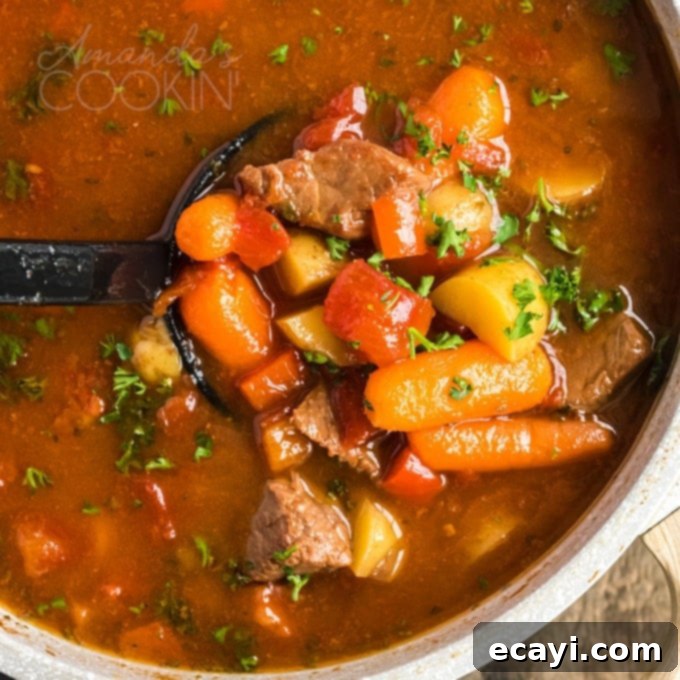Hearty Dutch Oven Goulash: Your Ultimate Comfort Food Recipe
There’s something uniquely satisfying about a rich, simmering stew, and this homemade Dutch oven goulash recipe delivers comfort in every spoonful. Perfect for any season, it’s an effortlessly delicious meal featuring tender beef chuck roast and classic root vegetables bathed in a savory, paprika-infused broth. Whether you’re seeking a warming dinner on a crisp autumn evening, a hearty meal after a chilly winter day, or a comforting weeknight staple for busy family schedules (especially those rain-soaked kids’ football games!), this goulash is an ideal choice. While this recipe focuses on the traditional Dutch oven method, don’t forget the versatility of goulash; our Slow Cooker Hungarian Goulash is another fantastic option for hands-off cooking.
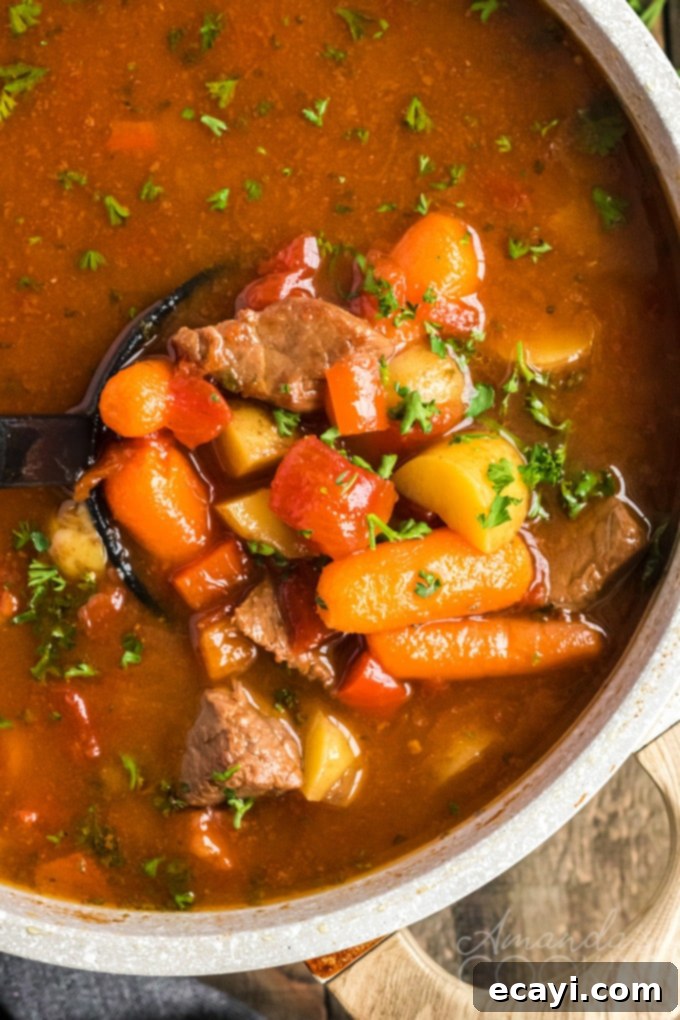
The Quintessential Homemade Goulash Recipe
This goulash recipe isn’t just a meal; it’s a culinary journey to a bowl of pure contentment. While stews are naturally embraced during the colder months, the robust flavors and nourishing ingredients make this a welcome addition to your dinner rotation year-round. Our rendition features succulent chunks of protein-packed beef chuck roast, married with a medley of classic root vegetables like potatoes and carrots, all brought together in an incredibly rich and aromatic broth. The secret lies in the generous use of sweet paprika and caraway seeds, which lend that signature warmth and depth characteristic of authentic goulash. It’s a dish that evokes memories of home-cooked goodness and is destined to become a cherished family favorite, whether it’s for a special “Sunday supper” or a much-needed weeknight pick-me-up.
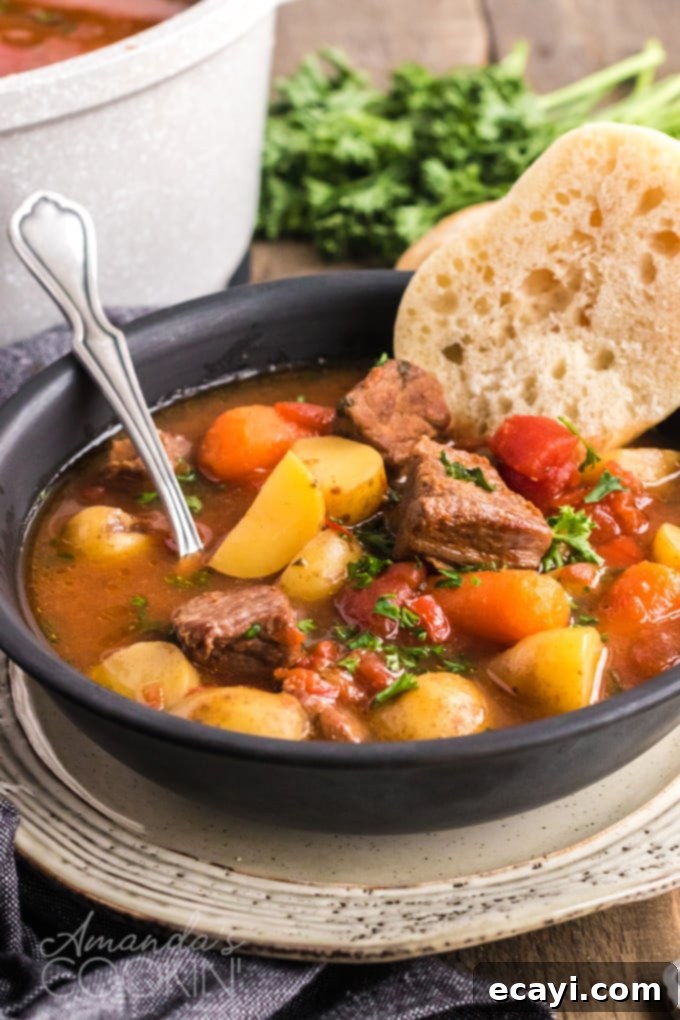
Essential Ingredients for Your Perfect Goulash
Crafting an unforgettable goulash starts with selecting quality ingredients. Here’s what you’ll need, along with a few notes to ensure the best flavor:
- 2 pounds beef chuck roast, cut into 1-inch cubes (or stew meat): Chuck roast is ideal for slow cooking; its marbling breaks down beautifully, resulting in incredibly tender beef. Stew meat is a convenient alternative.
- 1/4 cup sweet paprika: This is the star spice of goulash. Opt for a good quality Hungarian sweet paprika for the most authentic flavor.
- 1 teaspoon caraway seeds: These add a distinctive, slightly earthy and peppery note that is crucial to traditional goulash. Don’t skip them!
- 2 teaspoons dried marjoram: Marjoram complements beef and paprika wonderfully, adding a subtle herbaceousness.
- 2 teaspoon Kosher salt: Essential for seasoning the meat and the stew base. Adjust to taste.
- 1/2 teaspoon freshly ground black pepper: Freshly ground offers the best flavor.
- 1 heaping tablespoon all purpose flour: Used to coat the beef, it helps create a rich, thick sauce.
- 3 tablespoons olive oil: For sautéing the vegetables and browning the beef, building the initial flavor layers.
- 1 large yellow onion, chopped (approximately 1 cup): Onions caramelize beautifully and form a sweet, aromatic base.
- 1 teaspoon minced garlic (about two cloves): Garlic adds a pungent depth to the stew.
- 1 14-ounce can fire roasted diced tomatoes, undrained: Fire-roasted tomatoes add a smoky sweetness and acidity, enhancing the overall flavor profile.
- 5 cups beef broth: The liquid base for the stew. Use a good quality, low-sodium beef broth for best results.
- 2 tablespoons Worcestershire sauce: A secret weapon for adding umami and complexity.
- 1 1/2 cups baby carrots (approximately 8 ounces): Sweet and convenient, baby carrots add natural sweetness and color.
- 3 cups quartered baby Yukon Gold potatoes (approximately 1 pound): Yukon Golds hold their shape well and contribute a creamy texture without becoming mushy.
- 1 cup chopped sweet peppers (approximately 4 ounces): Added towards the end, these provide a pop of color, fresh flavor, and a slight crunch.
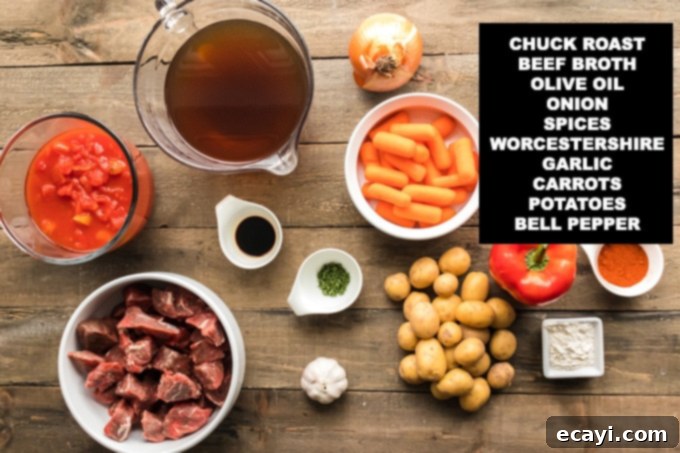
Helpful Kitchen Tools for Goulash Preparation:
Having the right tools can make your cooking experience smoother and more enjoyable. For this Dutch oven goulash, we recommend:
- Dutch oven: Essential for even heat distribution and slow simmering, providing the perfect environment for a tender stew.
- Ladle: Ideal for serving up generous portions of your delicious goulash.
- Wooden spoon: Great for stirring and scraping the bottom of the Dutch oven without damaging its surface.
- Serving bowls: To present your beautiful, hearty meal.
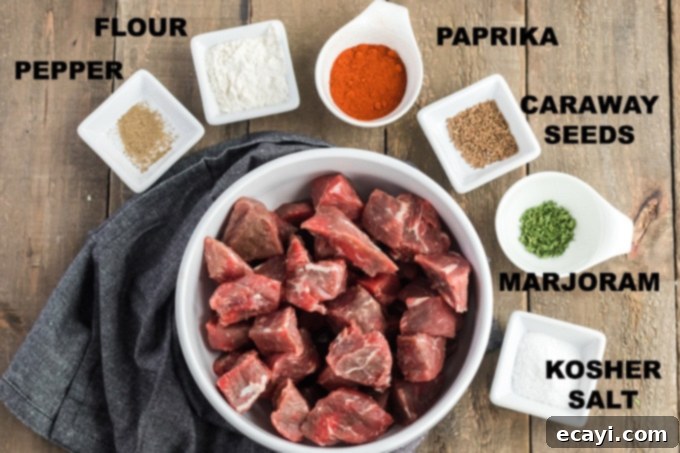
Step-by-Step Guide: How to Make Dutch Oven Goulash
Follow these detailed steps to create a truly memorable goulash. Each stage is designed to build layers of flavor, resulting in a wonderfully rich and tender stew.
- Season and Coat the Beef: In a large plastic zipper bag, combine the sweet paprika, caraway seeds, dried marjoram, Kosher salt, freshly ground black pepper, and all-purpose flour. Add the cubed beef chuck roast into the bag. Seal the bag tightly, ensuring some air remains inside, then shake vigorously until all the meat pieces are evenly coated with the spice and flour mixture. This step not only seasons the beef but also helps to thicken the stew later.
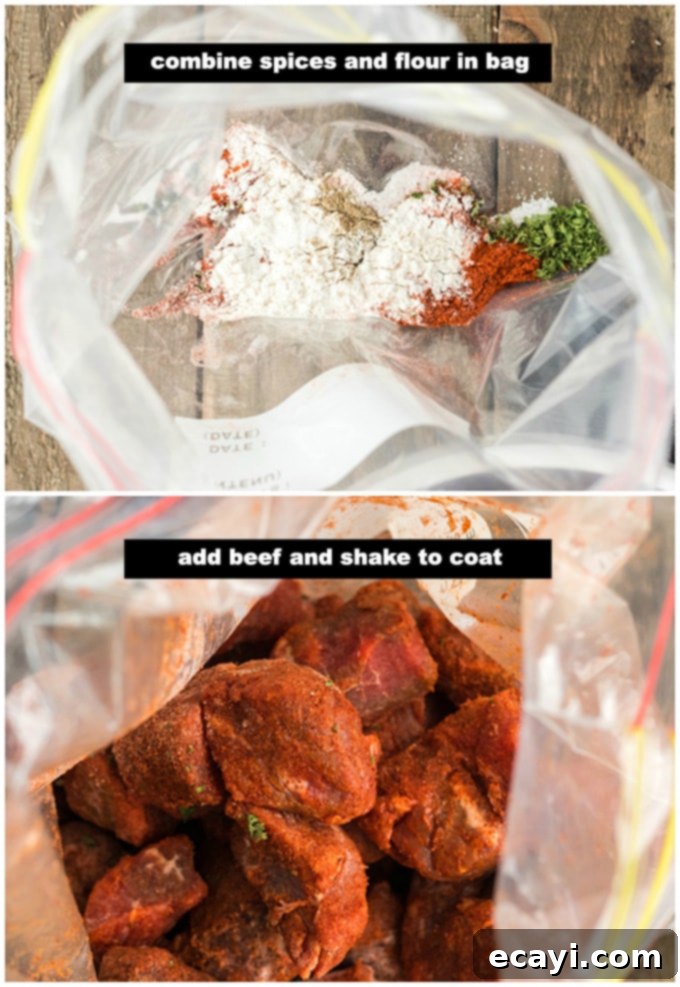
- Sauté the Aromatics: Heat the olive oil in your Dutch oven over medium heat. Add the chopped yellow onion and sauté until it becomes tender and translucent, typically about 3-4 minutes. Stir in the minced garlic and cook for another 30 seconds until fragrant. Be careful not to burn the garlic.
- Brown the Beef: Carefully pour the entire contents of the meat-shaking bag into the Dutch oven with the onion mixture. Cook the beef, turning occasionally with your wooden spoon, until all sides are well browned. This browning process is crucial for developing deep, rich flavors (the Maillard reaction). Don’t rush this step.
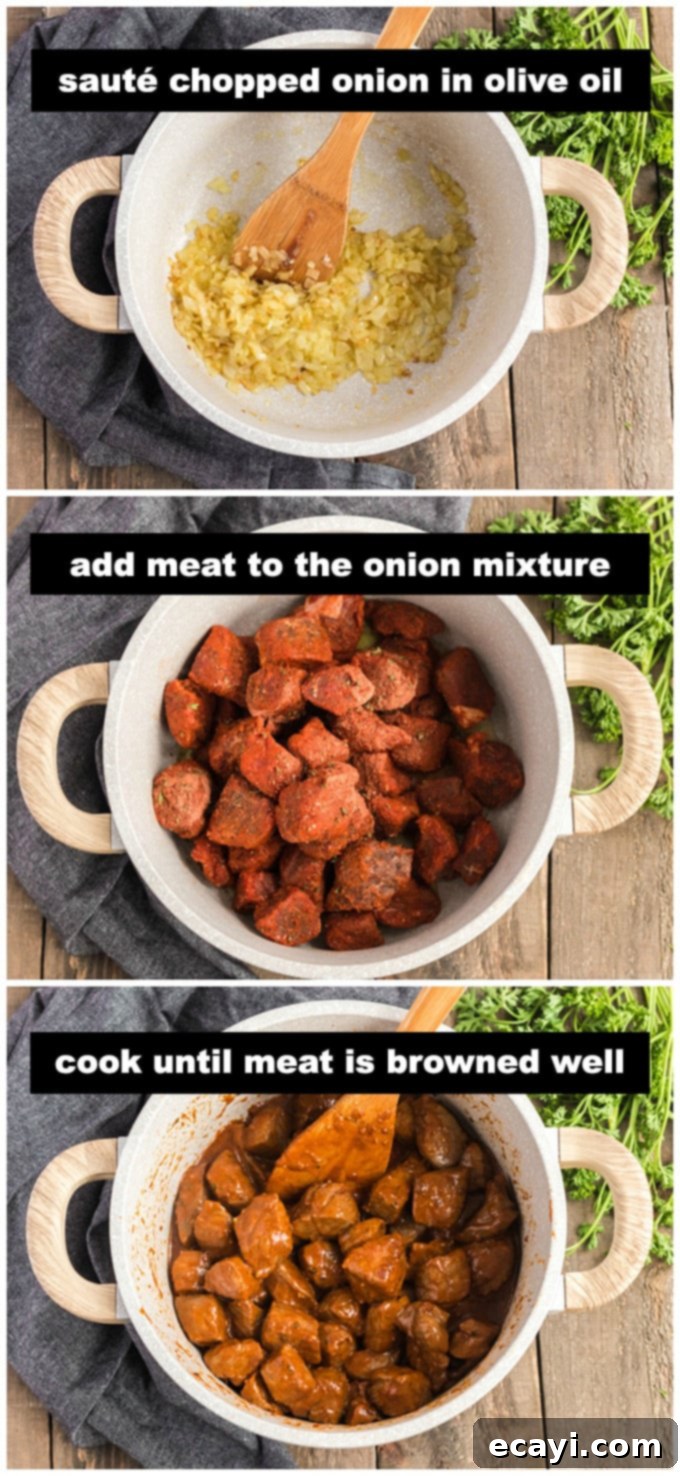
- Simmer the Base: Pour in the beef broth, Worcestershire sauce, and the can of fire-roasted diced tomatoes (including all their juices). Stir everything together to combine, making sure to scrape up any browned bits from the bottom of the pot, as these contain a lot of flavor. Bring the mixture to a boil, then reduce the heat to low. Allow the goulash to simmer uncovered for one hour. This initial simmering period allows the flavors to meld and the beef to begin tenderizing.
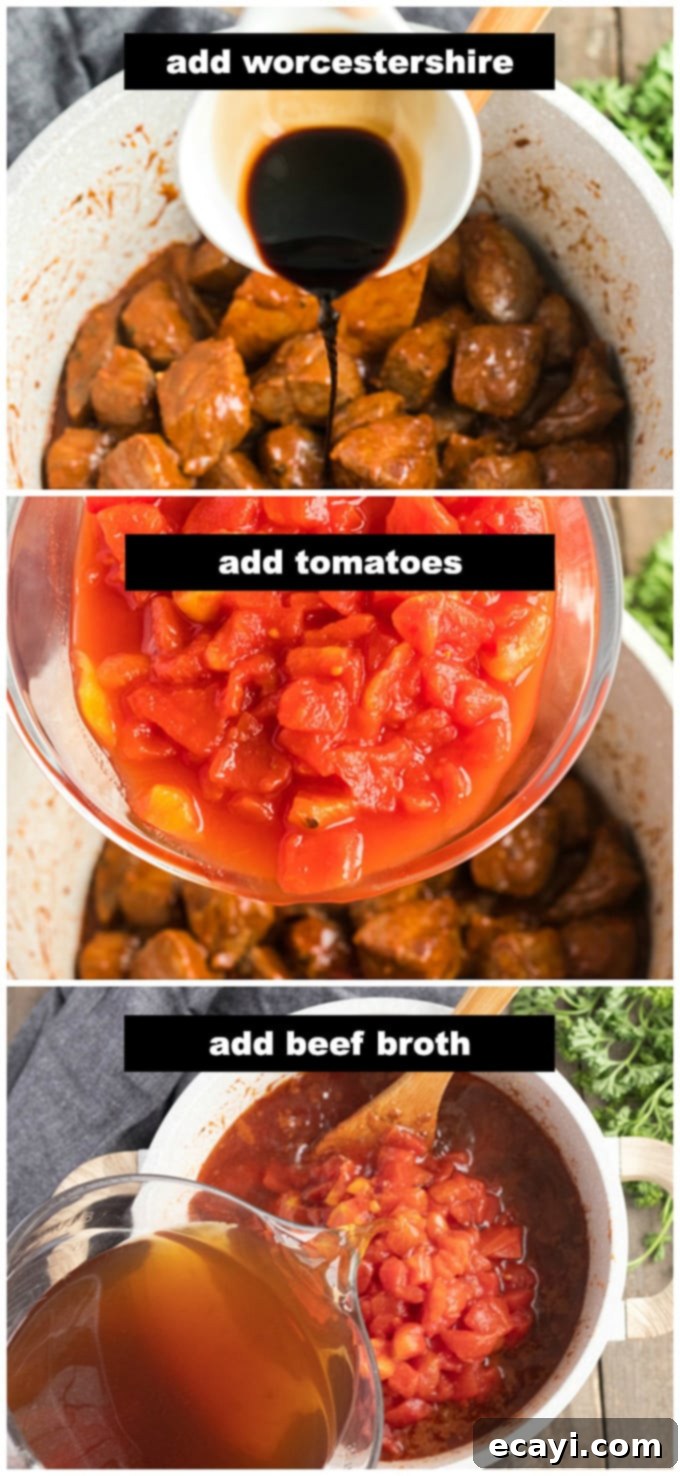
- Add Root Vegetables: Carefully add the baby carrots and quartered baby Yukon Gold potatoes to the Dutch oven and stir them into the stew. Cover the pot and continue to cook on low heat for another hour. The lid will help the vegetables steam and soften evenly while the beef continues to become incredibly tender.
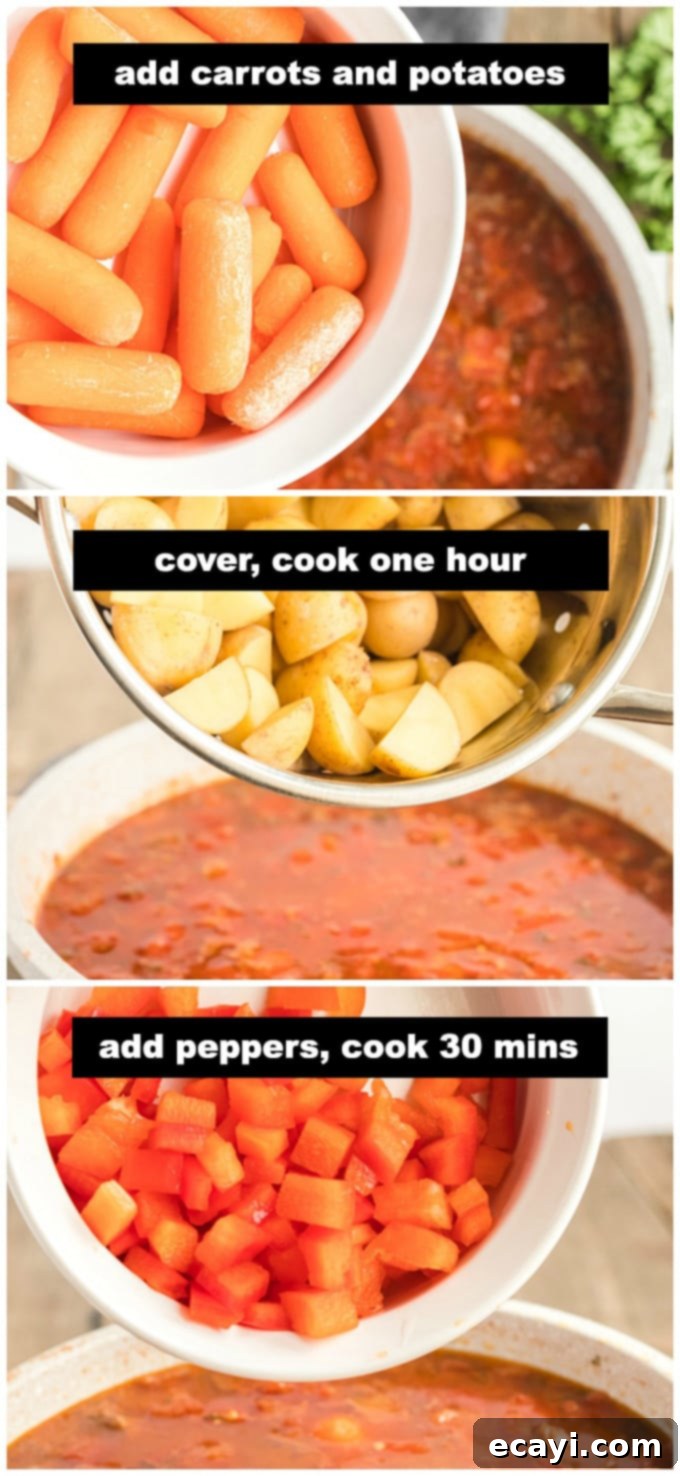
- Final Touches and Tenderizing: Finally, add the chopped sweet peppers to the stew and stir them in. Cover the pot once more and cook for an additional 30 minutes, or until both the beef and all the vegetables are fork-tender. The peppers added at this stage retain a bit of their freshness and vibrant color, contrasting beautifully with the rich stew. Serve hot and enjoy!
Perfect Pairings: Delicious Ideas to Serve with Your Goulash
A hearty bowl of goulash is a meal in itself, but it truly shines when paired with the right accompaniments. Here are some delectable ideas to complete your culinary experience:
- Crusty Italian Bread: Perfect for soaking up every last drop of that incredible sauce.
- Fluffy Homemade Biscuits: A warm, buttery biscuit provides a wonderful textural contrast.
- Savory Herb Buttermilk Biscuits: The added herbs in these biscuits complement the rich flavors of the goulash beautifully.
- Sweet Homemade Hawaiian Rolls: Their slight sweetness can balance the savory stew.
- Unique Bretzel Rolls: For something a little different, these pretzel-like rolls offer a chewy texture and distinct flavor.
- Creamy Sour Cream or Crème Fraîche: A dollop on top adds a refreshing tang and richness.
- Fresh Parsley or Dill: A sprinkle of fresh herbs provides a burst of color and aromatic freshness.
- Egg Noodles: For a more traditional American goulash experience, serving over wide egg noodles is a popular choice.
- Steamed Rice: A neutral base that absorbs the delicious broth.
- Simple Green Salad: A light, crisp salad can cut through the richness of the stew, offering a refreshing counterpoint.
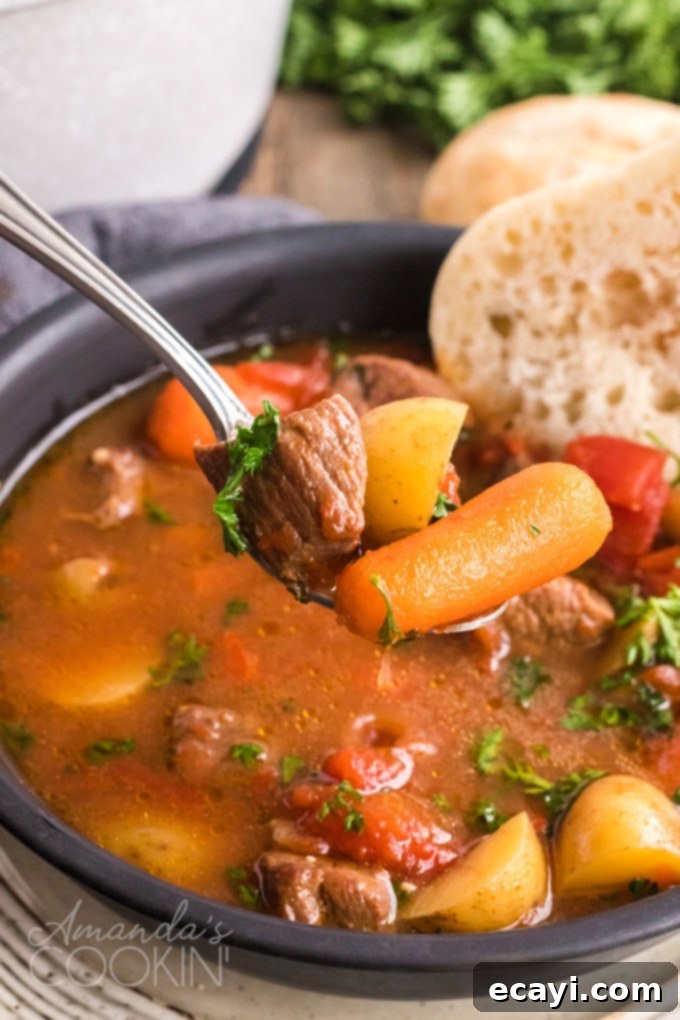
Unpacking Goulash: Interesting Facts and Rich History
Goulash is far more than just a stew; it’s a dish steeped in history and culinary evolution, inspiring countless variations worldwide. Let’s delve into some fascinating facts about this beloved comfort food:
- Defining Goulash: At its core, goulash is a meat-based soup or stew, prominently featuring vegetables and seasoned generously with paprika. The consistency can vary from a thin, soupy broth to a thick, hearty stew.
- Hungarian Origins: While commonly known as “Hungarian Goulash,” its roots genuinely lie in Hungary. The name “gulyás” originally referred to Hungarian herdsmen (gulyás means “herdsman”). These shepherds created a simple yet nourishing meal using meat and vegetables, seasoned with what was available.
- Global Popularity: Beyond its Hungarian birthplace, goulash has found immense popularity across central and southern Europe, and of course, it’s a staple in many households in the United States, often adapted to local tastes.
- Generational Recipes: It’s a true testament to its comforting appeal that most modern-day families often have a cherished goulash recipe passed down through generations, each with its unique twist.
- Diverse Variations: Goulash has evolved significantly, taking on many different forms. It’s cooked with a variety of vegetables, and you’ll find variations served with egg noodles (especially in American goulash), potatoes, or even dumplings, showcasing its incredible adaptability.
- Cooking Methods: Whether you prefer the traditional stovetop method, the hands-off convenience of an oven-baked version, or the ease of a slow cooker, goulash can be prepared using various cooking techniques, all yielding delicious results.
- Ancient Preservation Methods: Did you know that as far back as the 9th century, Hungarian herdsmen would cook and flavor meat, then dry it out in the sun? This preserved meat was packed into bags made from sheep’s stomachs. When out tending their flocks, they could simply add water to this dried mixture to create an instant, hearty meal. Thankfully, modern refrigeration and freezers mean we no longer need sheep’s stomachs to enjoy this ancient dish!
- The Role of Paprika: Paprika is the soul of goulash. It not only provides its characteristic reddish hue but also imparts a rich, sweet, and sometimes subtly smoky flavor that defines the dish. The quality of your paprika makes a significant difference.
There’s nothing quite like coming home to the enticing aroma and a steaming bowl of goulash on a brisk autumn day or a cold winter evening. It truly epitomizes comfort food, making it one of our ultimate favorites for a cozy “Sunday supper” during the colder months.
Frequently Asked Questions (FAQ) About Goulash
Here are answers to some common questions you might have about making goulash:
- What kind of beef is best for goulash?
Beef chuck roast is highly recommended. It has excellent marbling, which contributes to its tenderness and rich flavor after slow cooking. Stew meat (often pre-cut chuck) is also a good option for convenience.
- Can I make goulash in a slow cooker?
Absolutely! Goulash adapts wonderfully to a slow cooker. After browning the meat and sautéing the onions, transfer everything to your slow cooker, add the liquids and spices, and cook on low for 6-8 hours or on high for 3-4 hours, adding the softer vegetables (like sweet peppers) in the last hour to prevent them from becoming too mushy.
- How long does goulash last in the fridge/freezer?
Leftover goulash can be stored in an airtight container in the refrigerator for up to 3-4 days. For longer storage, it freezes exceptionally well for up to 3 months. Thaw overnight in the fridge and reheat gently on the stovetop or in the microwave.
- Can I add other vegetables?
Yes, goulash is very versatile! You can add other root vegetables like parsnips, turnips, or even bell peppers (in different colors for visual appeal) earlier in the cooking process. Green beans or peas can be added towards the end for a pop of freshness.
- What’s the difference between Hungarian and American goulash?
Traditional Hungarian goulash is typically a thin, soupy stew heavily flavored with paprika, often served with potatoes or dumplings. American goulash, on the other hand, is generally a thicker, heartier dish, often incorporating ground beef, macaroni noodles, and a tomato-based sauce, sometimes with less emphasis on paprika.
Explore More Hearty & Comforting Recipes
If you’ve enjoyed the comforting embrace of our Dutch oven goulash, you’re sure to love these other robust and satisfying dishes. Expand your culinary repertoire with these delicious ideas:
- For a delightful twist on the classic, consider making American turkey goulash, a lighter but equally flavorful alternative. Or, dive deeper into traditional preparations with beef goulash with dumplings, a wonderfully filling option, or a vibrant Hungarian goulash with peas and carrots for added sweetness and color.
- Beyond goulash, fall and winter are also prime seasons for some incredible crockpot beef stew! This hands-off recipe delivers tender beef and vegetables in a rich gravy, perfect for a cozy evening.
- If you’re a fan of hearty, beefy dishes that truly stick to your ribs, you will absolutely love our rich and savory beef burgundy prepared in the crock pot. It’s a simple yet elegant meal.
- For another classic comfort food that’s always a hit, my beef stroganoff recipe is one of my personal favorites! Creamy, savory, and utterly delicious.
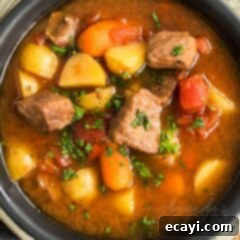
Dutch Oven Goulash
IMPORTANT – There are often Frequently Asked Questions within the blog post that you may find helpful. Simply scroll back up to read them!
Print It
Rate It
Save ItSaved!
Ingredients
- 2 pounds beef chuck roast cut into 1-inch cubes (or stew meat)
- ¼ cup sweet paprika
- 1 teaspoon caraway seeds
- 2 teaspoons dried marjoram
- 2 teaspoon Kosher salt
- ½ teaspoon freshly ground black pepper
- 1 heaping tablespoon all purpose flour
- 3 tablespoons olive oil
- 1 cup chopped yellow onion
- 1 teaspoon minced garlic about two cloves
- 14 ounce can fire roasted diced tomatoes undrained
- 5 cups beef broth
- 2 tablespoons Worcestershire sauce
- 8 ounces baby carrots about 1 1/2 cups
- 1 pound quartered baby Yukon Gold potatoes about 3 cups
- 4 ounces chopped sweet peppers about 1 cup
Things You’ll Need
-
5 qt Dutch oven
-
Ladle
-
Wooden spoon
-
Serving bowls
Before You Begin
Serve this goulash with one of these delicious ideas
- Italian Bread
- Homemade Biscuits
- Herb Buttermilk Biscuits
- Homemade Hawaiian Rolls
- Bretzel Rolls
Instructions
-
Combine paprika, caraway seeds, marjoram, Kosher salt, black pepper and flour in a large plastic zipper bag. Place cubed meat into the bag and close, then shake to coat thoroughly.
-
In a Dutch oven over medium heat, sauté chopped onion in olive oil until tender and translucent, about 3-4 minutes. Add minced garlic and sauté for another 30 seconds until fragrant.
-
Add the entire contents of the meat-shaking bag to the onion mixture in the pan. Cook, turning occasionally, until the meat is well browned on all sides.
-
Add beef broth, Worcestershire sauce, and the undrained canned fire-roasted tomatoes. Stir well to combine and bring to a boil. Reduce heat to low and simmer uncovered for one hour, allowing flavors to deepen.
-
Carefully add the baby carrots and quartered potatoes, then stir gently. Cover the Dutch oven and cook on low for an additional hour, until vegetables begin to soften.
-
Finally, add the chopped sweet peppers and stir. Cover and cook for another 30 minutes, or until the meat and all vegetables are fork-tender. Serve hot.
Nutrition
The recipes on this blog are tested with a conventional gas oven and gas stovetop. It’s important to note that some ovens, especially as they age, can cook and bake inconsistently. Using an inexpensive oven thermometer can assure you that your oven is truly heating to the proper temperature. If you use a toaster oven or countertop oven, please keep in mind that they may not distribute heat the same as a conventional full sized oven and you may need to adjust your cooking/baking times. In the case of recipes made with a pressure cooker, air fryer, slow cooker, or other appliance, a link to the appliances we use is listed within each respective recipe. For baking recipes where measurements are given by weight, please note that results may not be the same if cups are used instead, and we can’t guarantee success with that method.
This post originally appeared here on Oct 28, 2015, and has been updated with enhanced details and additional helpful information.
